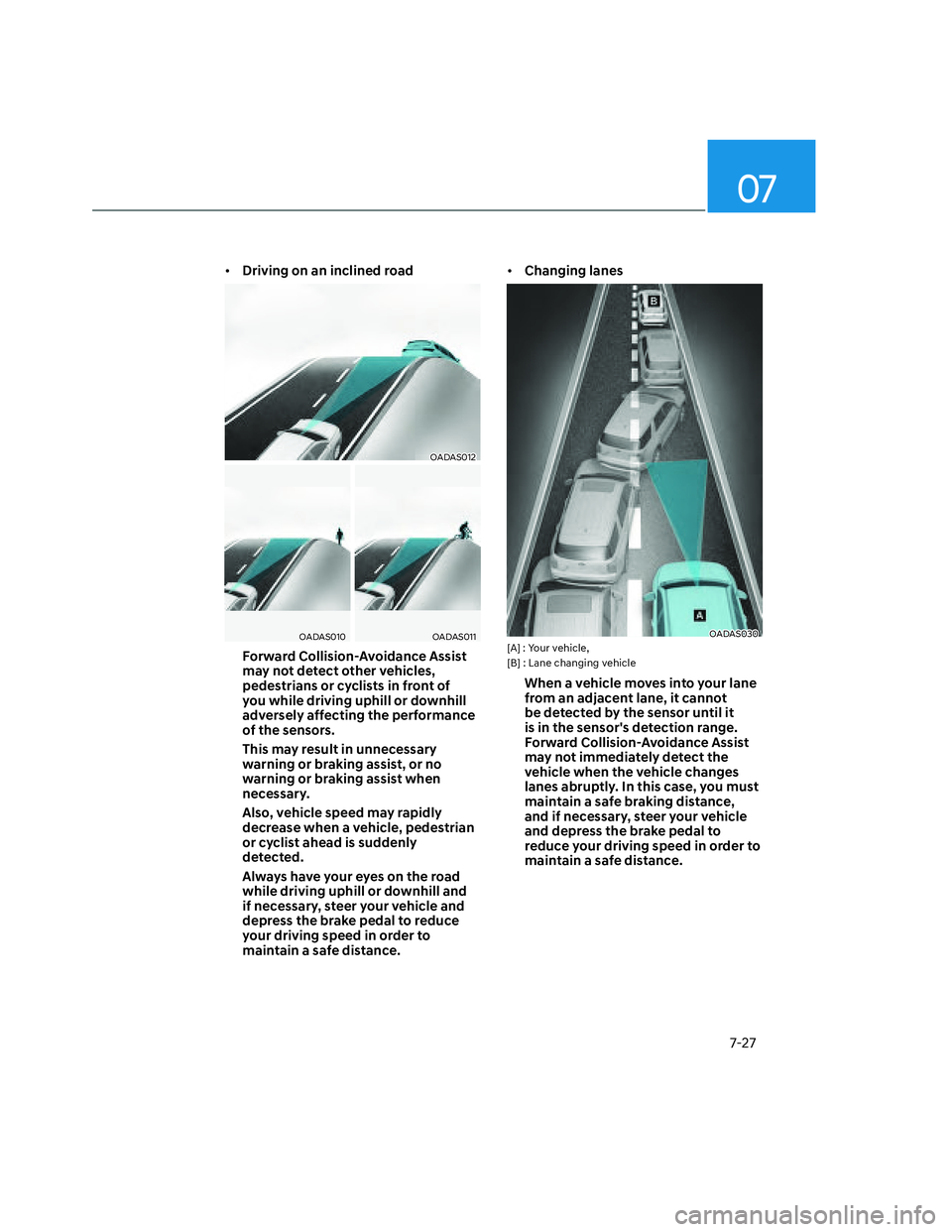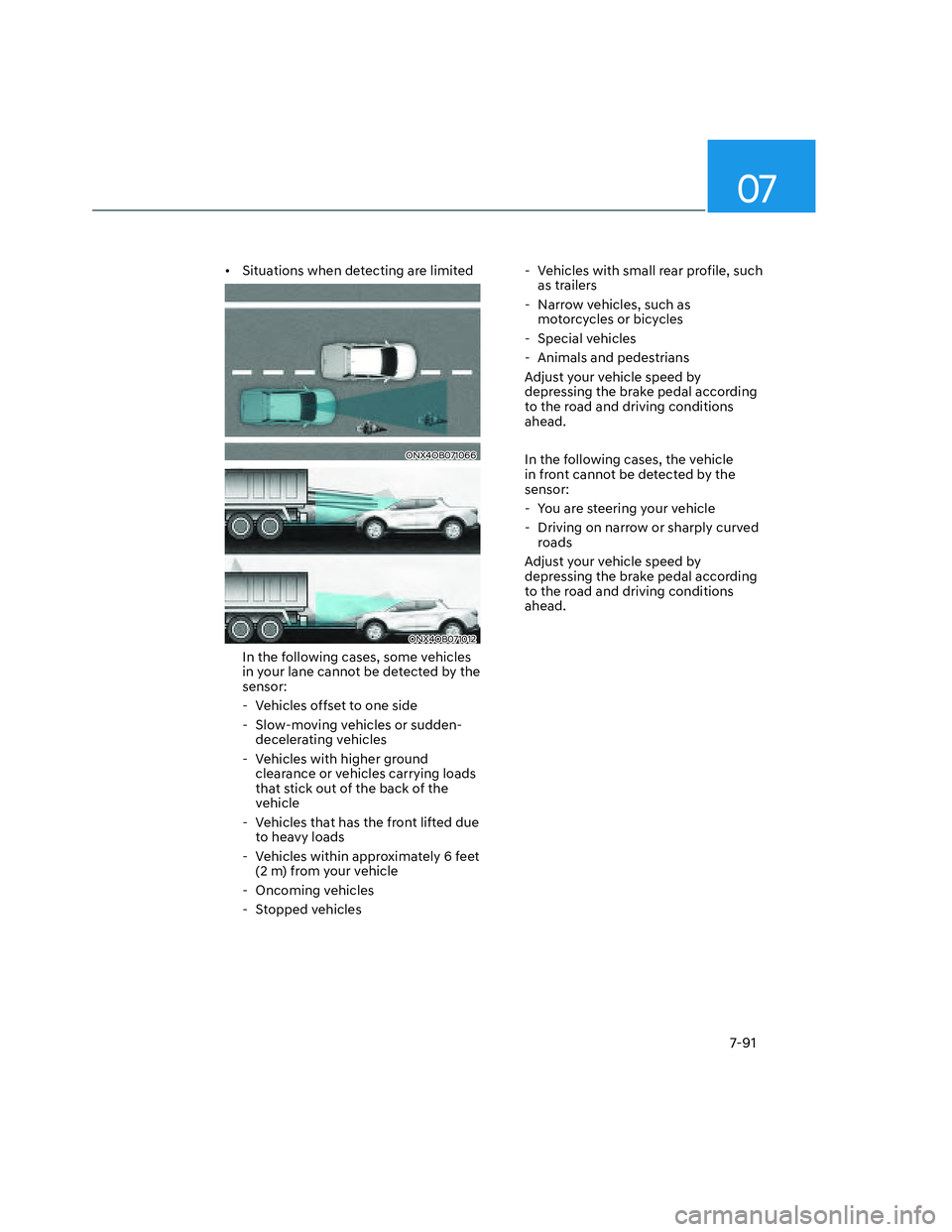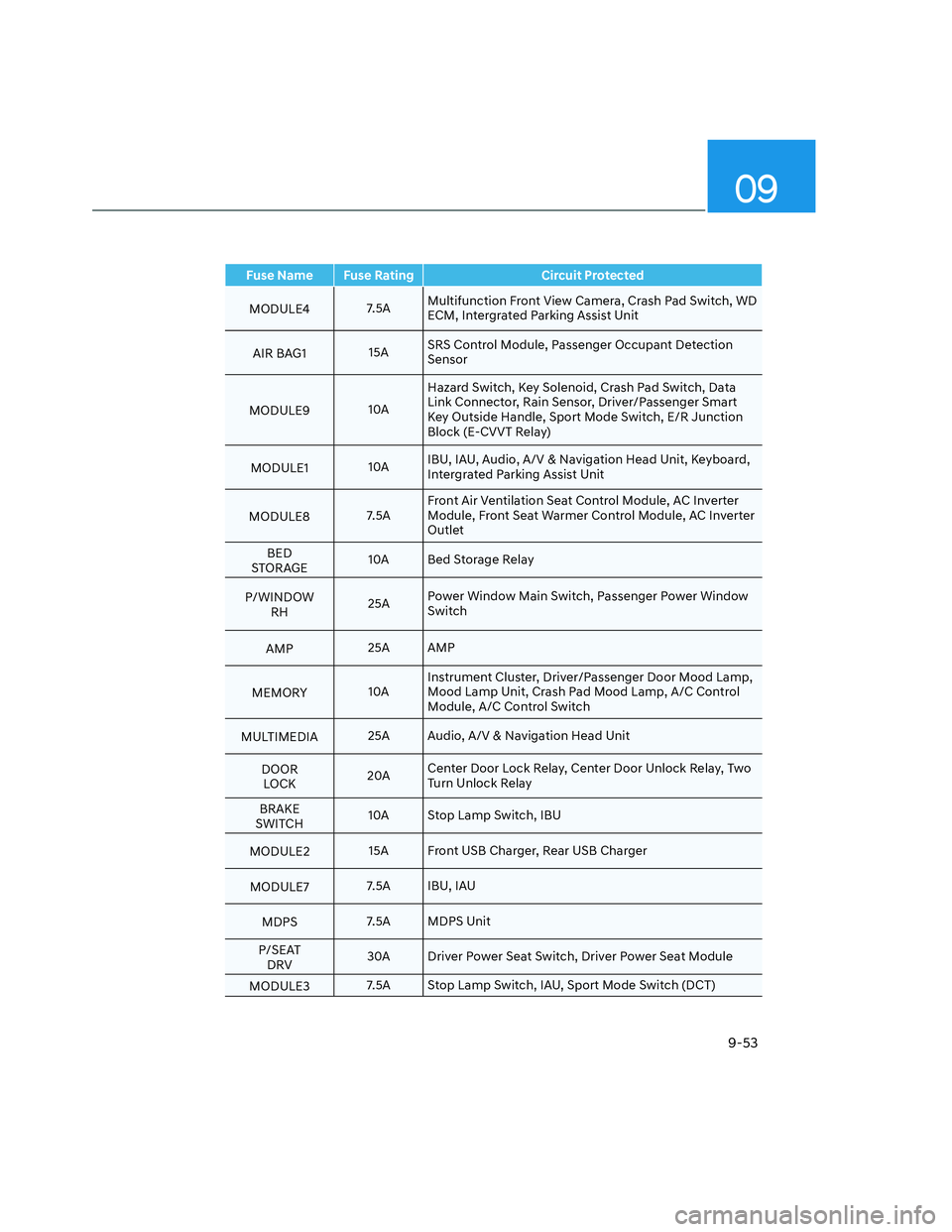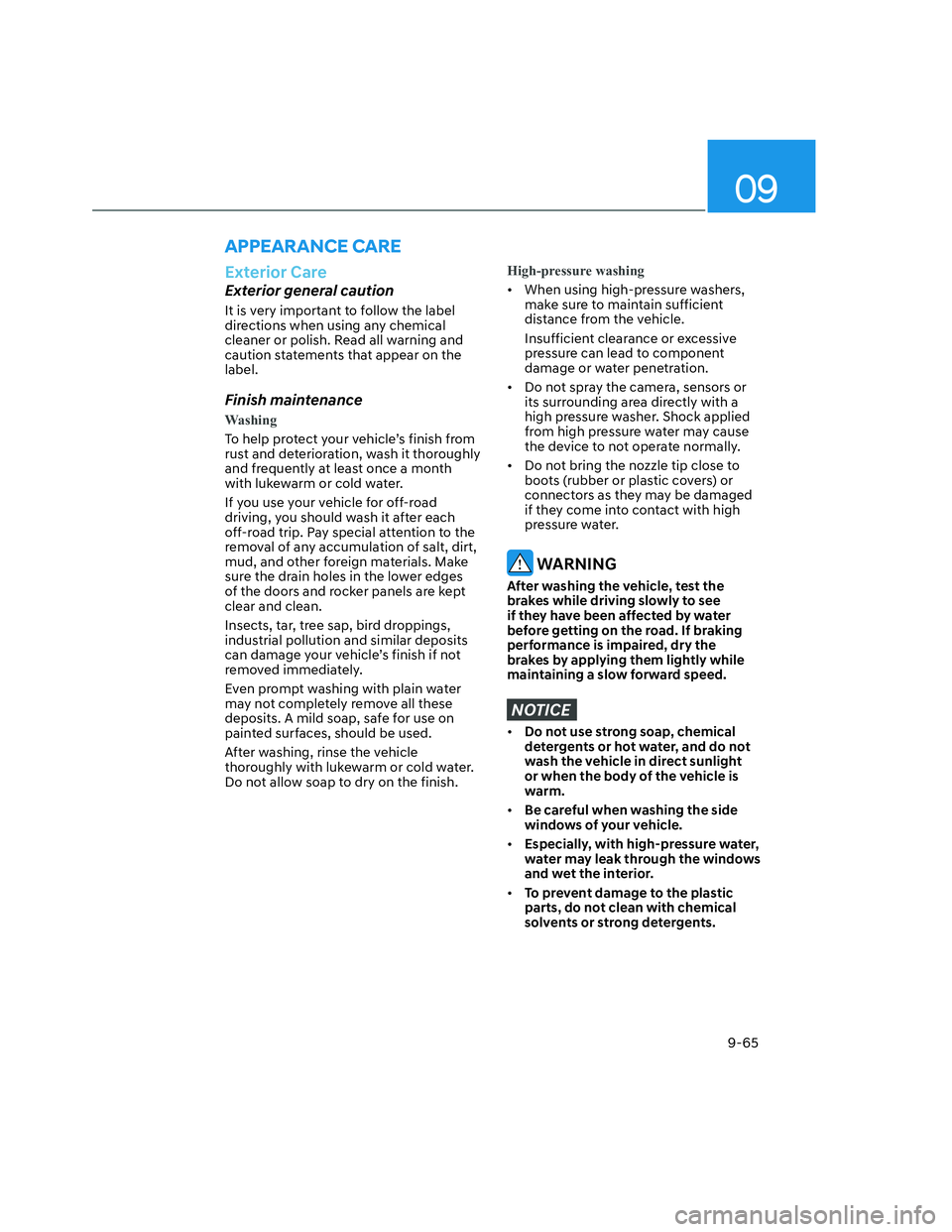Page 379 of 598

07
7-27
• Driving on an inclined road
OADAS012OADAS012
OADAS010OADAS010OADAS011OADAS011
Forward Collision-Avoidance Assist
may not detect other vehicles,
pedestrians or cyclists in front of
you while driving uphill or downhill
adversely affecting the performance
of the sensors.
This may result in unnecessary
warning or braking assist, or no
warning or braking assist when
necessary.
Also, vehicle speed may rapidly
decrease when a vehicle, pedestrian
or cyclist ahead is suddenly
detected.
Always have your eyes on the road
while driving uphill or downhill and
if necessary, steer your vehicle and
depress the brake pedal to reduce
your driving speed in order to
maintain a safe distance.• Changing lanes
OADAS030OADAS030[A] : Your vehicle,
[B] : Lane changing vehicle
When a vehicle moves into your lane
from an adjacent lane, it cannot
be detected by the sensor until it
is in the sensor's detection range.
Forward Collision-Avoidance Assist
may not immediately detect the
vehicle when the vehicle changes
lanes abruptly. In this case, you must
maintain a safe braking distance,
and if necessary, steer your vehicle
and depress the brake pedal to
reduce your driving speed in order to
maintain a safe distance.
Page 389 of 598
07
7-37
ONX4OB071020ONX4OB071020
When your vehicle is entering into the
flow of traffic from a parallel parking
space, if Blind-Spot Collision-Avoidance
Assist judges that there is a collision
risk with an approaching vehicle in the
blind spot, it can help avoid a collision by
applying the brake.
Detecting sensor
ONX4OB051017ONX4OB051017
ONX4OB071021ONX4OB071021[1] : Front view camera,
[2] : Rear corner radar
Refer to the picture above for the
detailed location of the detecting
sensors.
Page 442 of 598
Driver Assistance System
7-90
• Driving on an inclined road
OADAS012OADAS012
During uphill or downhill driving, the
Smart Cruise Control may not detect
a moving vehicle in your lane, and
cause your vehicle to accelerate to
the set speed. Also, vehicle speed will
rapidly decrease when the vehicle
ahead is detected suddenly.
Select the appropriate set speed on
inclines and apply the brake pedal or
accelerator pedal according to the
road and driving conditions ahead.• Changing lanes
OADAS030 OADAS030 [A] : Your vehicle, [B] : Lane changing vehicle
When a vehicle moves into your lane
from an adjacent lane, it cannot be
detected by the sensor until it is in the
sensor's detection range. Smart Cruise
Control may not immediately detect
the vehicle when the vehicle changes
lanes abruptly. In this case, you must
maintain a safe braking distance, and
if necessary, depress the brake pedal
to reduce your driving speed in order
to maintain a safe distance.
Page 443 of 598

07
7-91
• Situations when detecting are limited
ONX4OB071066ONX4OB071066
ONX4OB071012ONX4OB071012
In the following cases, some vehicles
in your lane cannot be detected by the
sensor:
- Vehicles offset to one side
- Slow-moving vehicles or sudden-
decelerating vehicles
- Vehicles with higher ground
clearance or vehicles carrying loads
that stick out of the back of the
vehicle
- Vehicles that has the front lifted due
to heavy loads
- Vehicles within approximately 6 feet
(2 m) from your vehicle
- Oncoming vehicles
- Stopped vehicles - Vehicles with small rear profile, such
as trailers
- Narrow vehicles, such as
motorcycles or bicycles
- Special vehicles
- Animals and pedestrians
Adjust your vehicle speed by
depressing the brake pedal according
to the road and driving conditions
ahead.
In the following cases, the vehicle
in front cannot be detected by the
sensor:
- You are steering your vehicle
- Driving on narrow or sharply curved
roads
Adjust your vehicle speed by
depressing the brake pedal according
to the road and driving conditions
ahead.
Page 497 of 598

08
8-13
If the indicators do not extinguish after a
few minutes, please visit an authorized
HYUNDAI dealer.
Each wheel is equipped with a tire
pressure sensor mounted inside the tire
behind the valve stem (except for the
spare tire). You must use TPMS specific
wheels. It is recommended that you
always have your tires serviced by an
authorized HYUNDAI dealer.
You may not be able to identify a tire
with low pressure by simply looking at it.
Always use a good quality tire pressure
gauge to measure. Please note that a tire
that is hot (from being driven) will have a
higher pressure measurement than a tire
that is cold.
A cold tire means the vehicle has been
sitting for 3 hours and driven for less
than 1 mile (1.6 km) in that 3 hour period.
Allow the tire to cool before measuring
the inflation pressure. Always be sure
the tire is cold before inflating to the
recommended pressure.
WARNING
• The TPMS cannot alert you to severe
and sudden tire damage caused by
external factors such as nails or road
debris.
• If you feel any vehicle instability,
immediately take your foot off
the accelerator, apply the brakes
gradually with light force, and slowly
move to a safe position off the road.
WARNING
Tampering with, modifying, or disabling
the Tire Pressure Monitoring System
(TPMS) components may interfere
with the system’s ability to warn the
driver of low tire pressure conditions
and/or TPMS malfunctions. Tampering
with, modifying, or disabling the Tire
Pressure Monitoring System (TPMS)
components may void the warranty for
that portion of the vehicle.
Information
This device complies with Part 15 of the
FCC rules.
Operation is subject to the following three
conditions:
1. This device may not cause harmful
interference.
2. This device must accept any
interference received, including
interference that may cause undesired
operation.
3. Changes or modifications not expressly
approved by the party responsible
for compliance could void the user’s
authority to operate the equipment.
Page 561 of 598

09
9-53
Fuse Name Fuse Rating Circuit Protected
MODULE47.5AMultifunction Front View Camera, Crash Pad Switch, WD
ECM, Intergrated Parking Assist Unit
AIR BAG115ASRS Control Module, Passenger Occupant Detection
Sensor
MODULE910AHazard Switch, Key Solenoid, Crash Pad Switch, Data
Link Connector, Rain Sensor, Driver/Passenger Smart
Key Outside Handle, Sport Mode Switch, E/R Junction
Block (E-CVVT Relay)
MODULE110AIBU, IAU, Audio, A/V & Navigation Head Unit, Keyboard,
Intergrated Parking Assist Unit
MODULE87.5AFront Air Ventilation Seat Control Module, AC Inverter
Module, Front Seat Warmer Control Module, AC Inverter
Outlet
BED
STORAGE10A Bed Storage Relay
P/WINDOW
RH25APower Window Main Switch, Passenger Power Window
Switch
AMP25A AMP
MEMORY10AInstrument Cluster, Driver/Passenger Door Mood Lamp,
Mood Lamp Unit, Crash Pad Mood Lamp, A/C Control
Module, A/C Control Switch
MULTIMEDIA25A Audio, A/V & Navigation Head Unit
DOOR
LOCK20ACenter Door Lock Relay, Center Door Unlock Relay, Two
Turn Unlock Relay
BRAKE
SWITCH10A Stop Lamp Switch, IBU
MODULE215A Front USB Charger, Rear USB Charger
MODULE77.5A IBU, IAU
MDPS7.5A MDPS Unit
P/SEAT
DRV30A Driver Power Seat Switch, Driver Power Seat Module
MODULE37.5A Stop Lamp Switch, IAU, Sport Mode Switch (DCT)
Page 563 of 598
![HYUNDAI SANTA CRUZ 2022 Owners Manual 09
9-55
Engine compartment fuse panel
Type Fuse NameFuse
RatingCircuit Protected
MULTI
FUSEMDPS80A MDPS Unit
COOLING FAN180A [G4KP] Cooling Fan Controller
COOLING FAN260A [G4KN] Cooling Fan Controlle HYUNDAI SANTA CRUZ 2022 Owners Manual 09
9-55
Engine compartment fuse panel
Type Fuse NameFuse
RatingCircuit Protected
MULTI
FUSEMDPS80A MDPS Unit
COOLING FAN180A [G4KP] Cooling Fan Controller
COOLING FAN260A [G4KN] Cooling Fan Controlle](/manual-img/35/41171/w960_41171-562.png)
09
9-55
Engine compartment fuse panel
Type Fuse NameFuse
RatingCircuit Protected
MULTI
FUSEMDPS80A MDPS Unit
COOLING FAN180A [G4KP] Cooling Fan Controller
COOLING FAN260A [G4KN] Cooling Fan Controller
B+260A ICU Junction Block (IPS7, IPS8, IPS9, IPS10, IPS11, IPS12)
B+360AICU Junction Block (Fuse - P/SEAT DRV, SAFETY P/
WINDOW RH, S/HEATER DRV/PASS, SUNROOF1, BED
STORAGE, Power Window Main Relay)
E-CVVT150A E/R Junction Block (E-CVVT Relay)
BLOWER40A E/R Junction Block (Blower Relay)
EPB140A ESC Module
REAR HEATED40A E/R Junction Block (Rear Heated Relay)
TRAILER 130A [G4KP] Trailer Connector
B+440AICU Junction Block (Fuse - DOOR LOCK, SAFETY P/
WINDOW LH, TAILGATE OPEN, AMP, IBU2, AIR BAG2,
CARGO LP, BRAKE SWITCH, MODULE9, Long Term
Load Latch Relay)
EPB260A ESC Module
FUEL PUMP20A E/R Junction Block (Fuel Pump Relay)
4WD20A AWD ECM
TRAILER 230A
[G4KN] Trailer Controller
AMS10A Battery Sensor
TRAILER 330A
[G4KN] Trailer Connector
ECU215A PCM/ECM
VACUUM PUMP120A
[G4KP] E/R Junction Block (Vacuum Pump Relay)
TCU115A [G4KN] PCM
ROOF LIGHT FRT15A Accessory Light Switch
E-CVVT220A [G4KP] ECM
HEATED MIRROR10AE/R Junction Block (Rear Heated Relay), Driver/
Passenger Power Outside Mirror
VACUUM PUMP210A [G4KP] ESC Module
TCU360A [G4KP] TCM
EOP60A [G4KP] Electronic Oil Pump
B+150A ICU Junction Block (IPS1, IPS3, IPS4, IPS5, IPS6,)
PTC HEATER50A E/R Junction Block (PTC Heater Relay)
INVERTER30A AC Inverter Module
Page 573 of 598

09
9-65
Exterior Care
Exterior general caution
It is very important to follow the label
directions when using any chemical
cleaner or polish. Read all warning and
caution statements that appear on the
label.
Finish maintenance
Washing
To help protect your vehicle’s finish from
rust and deterioration, wash it thoroughly
and frequently at least once a month
with lukewarm or cold water.
If you use your vehicle for off-road
driving, you should wash it after each
off-road trip. Pay special attention to the
removal of any accumulation of salt, dirt,
mud, and other foreign materials. Make
sure the drain holes in the lower edges
of the doors and rocker panels are kept
clear and clean.
Insects, tar, tree sap, bird droppings,
industrial pollution and similar deposits
can damage your vehicle’s finish if not
removed immediately.
Even prompt washing with plain water
may not completely remove all these
deposits. A mild soap, safe for use on
painted surfaces, should be used.
After washing, rinse the vehicle
thoroughly with lukewarm or cold water.
Do not allow soap to dry on the finish.
High-pressure washing
• When using high-pressure washers,
make sure to maintain sufficient
distance from the vehicle.
Insufficient clearance or excessive
pressure can lead to component
damage or water penetration.
• Do not spray the camera, sensors or
its surrounding area directly with a
high pressure washer. Shock applied
from high pressure water may cause
the device to not operate normally.
• Do not bring the nozzle tip close to
boots (rubber or plastic covers) or
connectors as they may be damaged
if they come into contact with high
pressure water.
WARNING
After washing the vehicle, test the
brakes while driving slowly to see
if they have been affected by water
before getting on the road. If braking
performance is impaired, dry the
brakes by applying them lightly while
maintaining a slow forward speed.
NOTICE
• Do not use strong soap, chemical
detergents or hot water, and do not
wash the vehicle in direct sunlight
or when the body of the vehicle is
warm.
• Be careful when washing the side
windows of your vehicle.
• Especially, with high-pressure water,
water may leak through the windows
and wet the interior.
• To prevent damage to the plastic
parts, do not clean with chemical
solvents or strong detergents.
APPEARANCE CARE